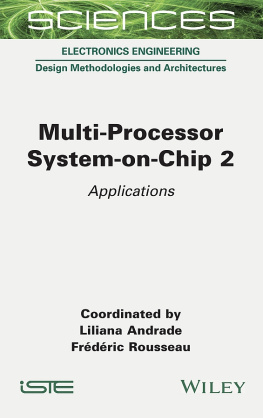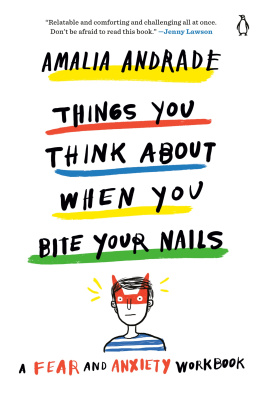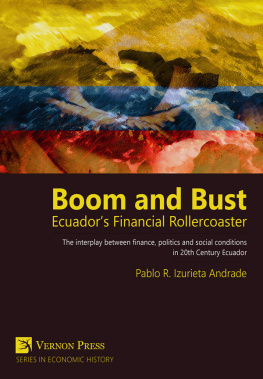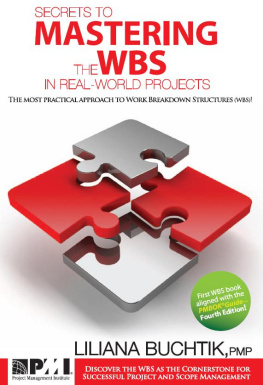Liliana Andrade - Multi-Processor System-On-Chip 2
Here you can read online Liliana Andrade - Multi-Processor System-On-Chip 2 full text of the book (entire story) in english for free. Download pdf and epub, get meaning, cover and reviews about this ebook. year: 2021, genre: Home and family. Description of the work, (preface) as well as reviews are available. Best literature library LitArk.com created for fans of good reading and offers a wide selection of genres:
Romance novel
Science fiction
Adventure
Detective
Science
History
Home and family
Prose
Art
Politics
Computer
Non-fiction
Religion
Business
Children
Humor
Choose a favorite category and find really read worthwhile books. Enjoy immersion in the world of imagination, feel the emotions of the characters or learn something new for yourself, make an fascinating discovery.
- Book:Multi-Processor System-On-Chip 2
- Author:
- Genre:
- Year:2021
- Rating:5 / 5
- Favourites:Add to favourites
- Your mark:
- 100
- 1
- 2
- 3
- 4
- 5
Multi-Processor System-On-Chip 2: summary, description and annotation
We offer to read an annotation, description, summary or preface (depends on what the author of the book "Multi-Processor System-On-Chip 2" wrote himself). If you haven't found the necessary information about the book — write in the comments, we will try to find it.
Multi-Processor System-On-Chip 2 — read online for free the complete book (whole text) full work
Below is the text of the book, divided by pages. System saving the place of the last page read, allows you to conveniently read the book "Multi-Processor System-On-Chip 2" online for free, without having to search again every time where you left off. Put a bookmark, and you can go to the page where you finished reading at any time.
Font size:
Interval:
Bookmark:

To my parents, sisters and husband, the loves and pillars of my life.
Liliana ANDRADE
I express my profound gratitude to Karine, my parents and all my family, for their help and support throughout all these years.
Frdric ROUSSEAU
SCIENCES
Electronics Engineering, Field Director Francis Balestra
Design Methodologies and Architecture,
Subject Head Ahmed Jerraya
Coordinated by
Liliana Andrade
Frdric Rousseau

First published 2020 in Great Britain and the United States by ISTE Ltd and John Wiley & Sons, Inc.
Apart from any fair dealing for the purposes of research or private study, or criticism or review, as permitted under the Copyright, Designs and Patents Act 1988, this publication may only be reproduced, stored or transmitted, in any form or by any means, with the prior permission in writing of the publishers, or in the case of reprographic reproduction in accordance with the terms and licenses issued by the CLA. Enquiries concerning reproduction outside these terms should be sent to the publishers at the undermentioned address:
ISTE Ltd
27-37 St Georges Road
London SW19 4EU
UK
www.iste.co.uk
John Wiley & Sons, Inc.
111 River Street
Hoboken, NJ 07030
USA
www.wiley.com
ISTE Ltd 2020
The rights of Liliana Andrade and Frdric Rousseau to be identified as the authors of this work have been asserted by them in accordance with the Copyright, Designs and Patents Act 1988.
Library of Congress Control Number: 2020940076
British Library Cataloguing-in-Publication Data
A CIP record for this book is available from the British Library
ISBN 978-1-78945-022-4
ERC code:
PE6 Computer Science and Informatics
PE6_1 Computer architecture, pervasive computing, ubiquitous computing
PE6_10 Web and information systems, database systems, information retrieval and digital libraries, data fusion
PE7 Systems and Communication Engineering
PE7_2 Electrical engineering: power components and/or systems
Ahmed JERRAYA
Cyber Physical Systems Programs, CEATech, Grenoble, France
Multi-core and multi-processor SoC (MPSoC) concepts started in the late 1990s, mainly to mitigate the complexity of application-specific integrated circuits (ASICs) and to bring some flexibility. The integration of instruction-set processors into ASIC design aimed both to structure the architecture and to allow for programmability. The concept was adopted for general-purpose CPU and GPU in the second phase. Among the pioneers of MPSoC design, we can list the MPA architecture from ST that used eight specific cores to implement MPEG4 in 1998. This evolved 10 years later to give rise to MPPA, the Kalrays general-purpose MPSoC architecture. Another pioneer is the emotion engine from Sony that used five cores (two DSP and three RISC) to build the application processor for the PlayStation (PS2). This also evolved and later converged to bring the CELL architecture (developed jointly by Sony, IBM and Toshiba) in 2005. In 2000, Lucent announced Daytona (quad SPARC V8), and in 2001, Philips designed the famous Viper architecture that combined a MIPS architecture and a DSP (Trimedia). In 2004, TI introduced the OMAP architecture that combined an ARM and a DSP. Using MPSoC to build specific architectures is continuing, and almost every SoC produced today is a multi (or many) core architecture. An important evolution took place in 2005 with the ARM MPCore, the first general-purpose quad core. This was followed by several commercial, general-purpose multi-cores, including Intel Core Duo Pentium, AMD Opteron, Niagra Spark, the Cell processor (8 Cell cores + PowerPC, ring network).
MPSoC started a new computing era, but brought a twofold challenge: building multi-core HW that can be used easily by SW designers, and building distributed SW that fully exploits HW capabilities. To deal with these challenges, the design communities from Academia and Industry began a series of conferences and workshops to rethink classical distributed computing. The study of new methods, models and tools to deal with these new distributed HW and SW architectures generated new concepts, such as the interconnect architectures called network-on-chip (NoC). The MPSoC Forum, created in 2001, was the first interdisciplinary forum that brought together the leading thinkers from the different fields to design multi-core and multi-processor SoC. Over the last 20 years, MPSoC was a unique opportunity for me to meet so many of the worlds top researchers and to communicate with them in person, in addition to enjoying the high-quality conference programs. The confluence of academic and industrial perspectives, and hardware and software, makes MPSoC not yet another conference. I have learned how emerging SW and HW design technologies and architectures can benefit from advanced semiconductor manufacturing technologies to build energy-efficient multi-core architectures that can serve advanced computing (image, vision and cloud) and distributed networked systems. This book, in two volumes (Architectures and Applications), was published to celebrate the 20th anniversary of MPSoC with outstanding contributions from previous MPSoC events.
This first volume on architectures covers the key components of MPSoC: processors, memory, interconnect and interfaces.
Liliana ANDRADE and Frdric ROUSSEAU
Universit Grenoble Alpes, CNRS, Grenoble INP, TIMA, 38000 Grenoble, France
The editors are indebted to the MPSoC community who made this book possible. First of all, they acknowledge the societies that supported this project. EDAA and IEEE/CAS partially funded the organization of the first two events. Since its creation, IEEE/CEDA has sponsored the event. Industrial sponsors played a vital role in keeping MPSoC alive for the last 20 years; special thanks to Synopsys, Arteris, ARM, XILINX and Socionext. The event was created by a nucleus of several people who now form the steering committee (Ahmed Jerraya, Hannu Tenhunen, Marilyn Wolf, Masaharu Imai and Hiroto Yasuura). A larger group has, for the last 20 years, been working to form the community (Nicolas Ventroux, Jishen Zhao, Tsuyoshi Isshiki, Frdric Rousseau, Anca Molnos, Gabriela Nicolescu, Hiroyuki Tomiyama, Masaaki Kondo, Hiroki Matsutani, Tohru Ishihara, Pierre-Emmanuel Gaillardon, Yoshinori Takeuchi, Tom Becnel, Frdric Ptrot, Yuan Xie, Koji Inoue, Masaaki Kondo, Hideki Takase and Raphal David). The editors would like to acknowledge the outstanding contribution of the MPSoC speakers, and especially those who contributed to the chapters of this book. Finally, the editors would like to thank the people who participated in the careful reading of this book (Breytner Fernandez and Bruno Ferres).
MPSoC for Telecom
From Challenges to Hardware Requirements for Wireless Communications Reaching 6G
Stefan A. DAMJANCEVIC
Vodafone Chair Mobile, Communications Systems, TU Dresden, Germany
Synopsys, Saint Petersburg, Russia
Solutions Group, Synopsys, Inc., Eindhoven, The Netherlands
Barkhausen Institut, TU Dresden, Germany
Over the past few decades, we have seen rapid innovation in wireless communications. In particular, the IEEE 802.11 and 3GPP standardization organizations have driven data rates into the
Next pageFont size:
Interval:
Bookmark:
Similar books «Multi-Processor System-On-Chip 2»
Look at similar books to Multi-Processor System-On-Chip 2. We have selected literature similar in name and meaning in the hope of providing readers with more options to find new, interesting, not yet read works.
Discussion, reviews of the book Multi-Processor System-On-Chip 2 and just readers' own opinions. Leave your comments, write what you think about the work, its meaning or the main characters. Specify what exactly you liked and what you didn't like, and why you think so.













